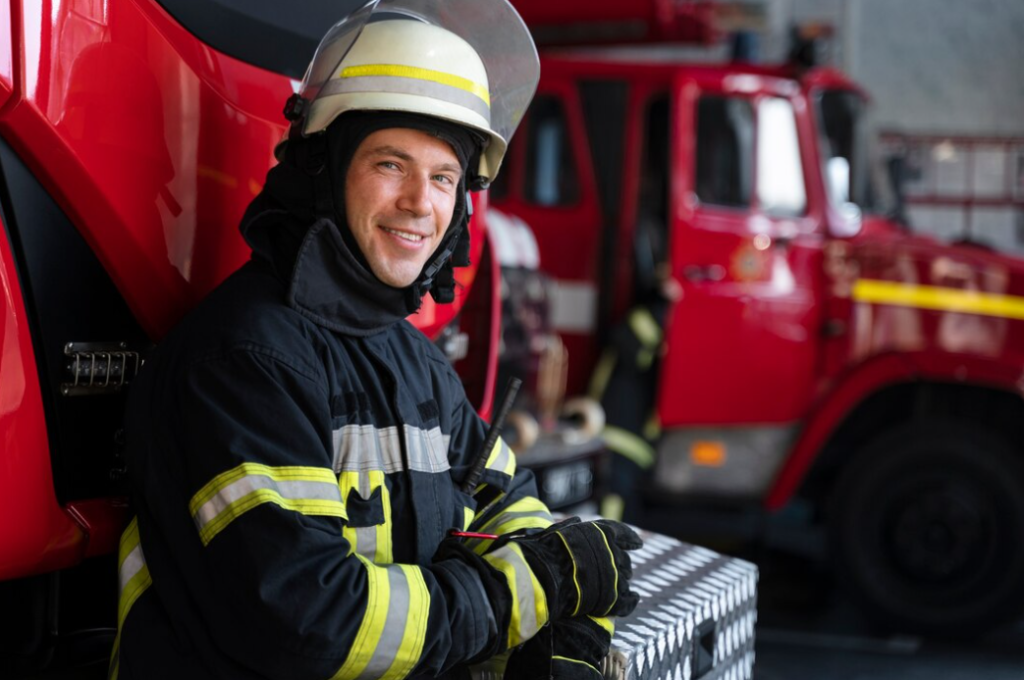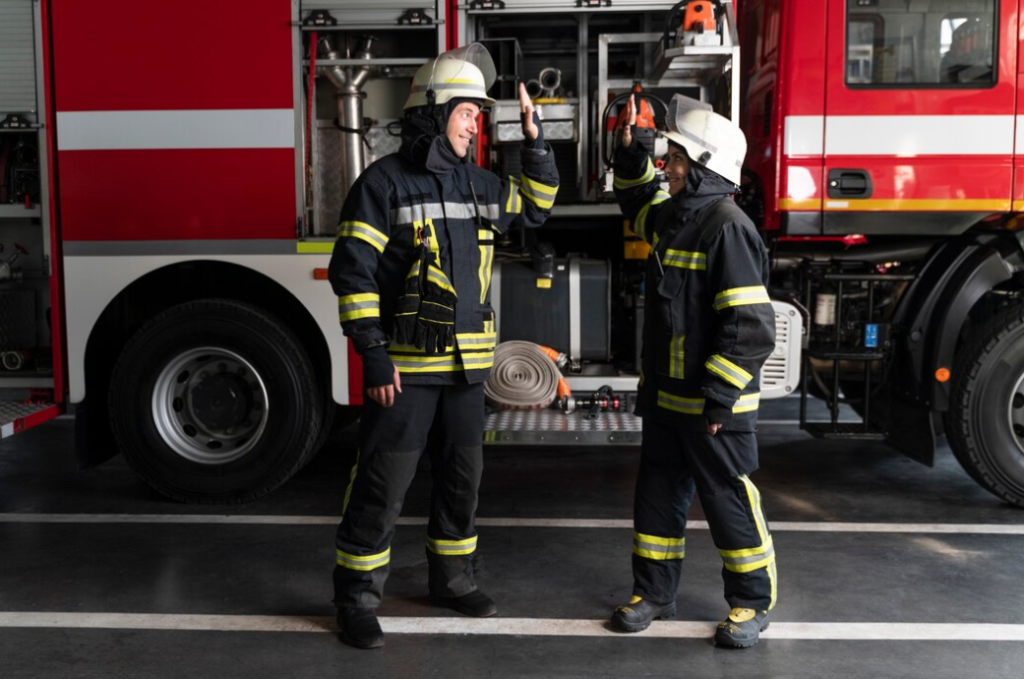The ranking system progresses as such, starting from the most junior to the senior-most position: Probationary Firefighter, Firefighter, Driver Engineer, Lieutenant, Captain, Battalion Chief, Assistant Chief, and Fire Chief. For all positions up to the Assistant Chief, promotions are facilitated through the state’s civil service examination process.
Structure and Roles within Fire Department Units
Fire Department teams are typically segmented into several primary classifications.
- Company(s) – Consider this as the foundational team. It consists of a single apparatus along with its crew. Often, an officer oversees this unit. For instance, a Lieutenant generally oversees Engine or Rescue Companies, while a Captain is in charge of a Ladder/Truck Company. If a Captain is unavailable (due to vacation, sickness, or other duties), a Lieutenant often steps up to fill the role, being termed an “Acting Captain” for that duration. Similarly, in the absence of a Lieutenant, the Driver Engineer assumes the role, becoming an “Acting Lieutenant.”
- Battalion(s) – Presently, the city operates a single Battalion. This generally comprises 4 to 5 stations and the respective companies stationed there. A Battalion Chief supervises these companies and their personnel. For every one of the three shifts, a Battalion Chief (BC) is designated. Furthermore, Battalion Chiefs hold key roles in staff positions, such as those in Training & Safety.
Fire Department Ranks in Order
Fire brigades are structured into specific sections depending on their functions. At the heart of an engine or truck unit lies the main vehicle, flanked by its fire combat or EMS crew. These units are usually led by a lieutenant or captain.
Some sectors within the brigade concentrate on particular duties, such as EMS or targeted rescue missions in risky environments. Personnel in these sectors receive specialized training suited to their distinct roles. A battalion consists of several fire outposts and the associated units.
- Probationary Firefighter (PFF) – An entry-level position undergoing training and evaluation during the first year of employment.
- Firefighter (FF) – A fundamental role, handling tasks such as hose placement, fire suppression, and search and rescue. Often, 1-2 are found in most companies. If the Driver Engineer is absent, the FF steps up as the “Acting DE”. While “Firefighter” denotes all department members, it’s also a specific rank.
- Driver Engineer (DE) – Known by various names, including “Chauffeur” and “Fire Equipment Operator”, they drive the fire vehicles and handle equipment like fire pumps. They’re specialists for their apparatus. If the Lieutenant is absent, the DE serves as the “Acting LT”.
- Lieutenant (LT) – An officer overseeing daily tasks, training, and emergencies for an Engine or Rescue Company. If the Captain isn’t present, the Lieutenant serves as the “Acting Capt”.
- Captain (CAPT) – An officer supervising a Ladder/Truck Company, its daily operations, and possibly other Lieutenants. They initially command emergencies and might oversee specialized sections like Training or EMS.
- Battalion Chief (BC) – The linchpin for daily operations. With 168 hours in a week and most higher-ranked officials working only 40, the BC often holds the top rank on duty. They ensure enough staff are on hand, manage scheduling, handle emergency situations, and oversee every battalion detail. Their role is comprehensive, from logistics and paperwork to emergency coordination.
- Assistant Chief – Oversees the Operations Division and its activities. This includes administrative tasks, strategic planning, ensuring fire service quality, and assisting the Fire Chief in administrative duties like budgeting and future station planning.
- Fire Chief – the highest rank in fire department, responsible for its efficient functioning. Their duties span from supervising the entire department, fire safety education, and emergency services to providing crucial assistance to the City Manager.
Fire Department Ladder: Roles and Responsibilities

Probationary Firefighter
These are the newest recruits in the fire department, hired on an “at will” basis and positioned at the entry-level. They stand as the freshest and least experienced members within the fire service realm.
During their initial phase of employment, which can span between six to twelve months, these probationary firefighters undergo rigorous training and assessments. This period ensures they align with the elevated standards of skill and character demanded by the fire service.
After successfully navigating their probation, they are inducted as permanent members of the fire brigade.
The hierarchy within fire departments ensures effective command and coordination, a concept that is equally important in understanding how link building agencies operate for success.
Firefighter
The term “firefighter” can refer to any member of the fire department, but it also denotes a specific rank within the structure.
Primarily, firefighters are at the forefront of fire combat, taking on roles such as fire suppression and search and rescue operations. It’s common to find one or two firefighters in each unit.
If the driver engineer is unavailable, the firefighter might step in to operate the vehicle.
Earnings for firefighters can vary based on the location of their service. Typically, in medium to large urban areas, the starting salary ranges from $30,000 to $50,000.
For context, the starting annual salary for a firefighter at the Irving (Texas) Fire Department is $54,744, with subsequent periodic raises. A firefighter, without progressing in rank, can culminate their service tenure earning around $83,136 annually. This pay scale is in line with other fire departments in the Dallas/Ft-Worth vicinity.
Driver Engineer (DE), or Fire Equipment Operator (FEO)
The driver engineer has the crucial role of operating the fire vehicle. Their duties encompass the upkeep and operation of the fire pump and aerial ladder.
Holding this position demands a keen attention to detail. Regular inspections of the vehicle are imperative to ensure its functionality. After each call, equipment must be cleaned and maintained, and at a minimum, checked every morning prior to a shift.
Driver engineers are expected to be thoroughly acquainted with the fire vehicle, ensuring its optimum performance during emergencies. This is vital as they may need to swiftly rectify issues with the pump or other essential equipment on-site.
If the lieutenant is unavailable, the driver engineer can step in as the “acting lieutenant.” Being the first instance in their career to take on an officer’s role, it’s essential for driver engineers to exhibit leadership and organizational skills.
Alternate titles for this role include “chauffeur,” “apparatus operator (AO),” and “fire equipment operator” (FEO).
Given the weight of their responsibilities, promotion to driver engineer comes with a notable salary increment. For instance, in Irving, Texas, while firefighters begin with an annual salary of $54,744, their earnings rise to $85,860 upon advancing to equipment operator.
Lieutenant
Lieutenants helm the emergency response of a designated company, which includes overseeing resources and personnel.
Outside immediate emergencies, lieutenants often guide daily routines within the fire unit and lead training sessions for firefighters. This training can span from updating EMS capabilities to designing detailed maps of local structures for efficient fire response.
Given their directive role in operations, lieutenants need to be well-versed in on-site procedures and continuously aim for higher knowledge than their team members.
If a captain is unavailable, the lieutenant steps up as the “acting captain.”
At FDNY, lieutenants’ salaries commence at $94,300 annually, potentially escalating to $125,848 when accounting for overtime and holiday bonuses.
Captain
Captains usually assume the top leadership role during emergencies, orchestrating operations as required. They often represent the company in interactions with the media or the general public.
In the fire station, captains steer the daily functions and training programs. They consolidate reports from lieutenants and make administrative determinations for the team’s benefit. Their amplified duties mean they should possess stellar organizational and management skills.
Captains might also spearhead specialized departments, such as training or EMS, and could be the company’s spokesperson to the media and public.
Starting salaries for fire captains in the FDNY are pegged at $130,437. Upon promotion to captain, certain firefighters might further ascend to the rank of fire chief.
Fire chiefs, as the apex officers in the fire service hierarchy, typically lead operations during emergencies. They often approach scenes in distinct vehicles, like marked SUVs, which can double as on-the-go incident command posts.

Battalion Chief
Battalion chiefs often rank as the top officers on duty. They are instrumental in orchestrating work schedules and supervising personnel across the fire stations they oversee.
A crucial duty they perform is ensuring adequate staffing before the culmination of one shift and the onset of the next. This entails navigating the intricate task of rostering each fire department role, accommodating for vacations, and managing the unpredictability of sick days for a vast cohort of firefighters.
To ensure smooth operations, battalion chiefs often have to reallocate firefighters between stations and devise innovative staffing solutions. Most departments maintain about three rotating chiefs to guarantee consistent coverage round-the-clock.
Starting salaries for battalion chiefs in Seattle’s King County Fire Department hover around $134,376.
Assistant Chief
Overseeing the operations division, assistant fire chiefs direct activities pivotal to fire suppression and disaster mitigation. Depending on the department’s breadth, this could encompass EMS as well.
These chiefs spearhead initiatives to fortify and refine the fire service, aiding the fire chief in budget preparations and strategizing fire service growth.
In 2019, San Francisco’s top-earning assistant fire chief received a commendable $321,073.
Fire Chief
Standing at the zenith of the fire department hierarchy is the fire chief. The fire chief shoulders the paramount responsibility of steering the fire department towards efficiency, wielding authority over all its undertakings and staff.
Their purview extends to diverse department facets like:
- Fire safety education
- Fire protection
- EMS services
- Disaster readiness
- Administrative tasks
Furthermore, they may extend technical counsel to city officials like the city manager or mayor, championing the needs and concerns of the fire service during urban planning.
From their initial steps as probationary firefighters, individuals can chart their ascent up to the coveted fire chief position. With this progression comes the mantle of greater administrative or leadership roles. Beyond tactical fire suppression, they are entrusted with grooming the forthcoming firefighter generations and advocating for the fire service within their jurisdiction.
Conclusion
The intricate hierarchy within fire departments underpins the highly organized nature of firefighting and emergency response. From the zealous beginnings of a probationary firefighter to the strategic oversight of a fire chief, each rank delineates specific roles and responsibilities crucial to the seamless functioning of the fire department. As firefighters climb this ladder, their roles evolve from hands-on fire combat to a blend of leadership, administration, and strategic planning, reflecting the multifaceted demands of the fire service realm. Such a systematic approach not only ensures optimal emergency response but also offers clear career pathways, fostering professional growth and continuity in this life-saving profession. Whether on the front lines or behind the scenes, every member within this hierarchy plays a pivotal role in safeguarding communities and upholding the proud legacy of the fire service.